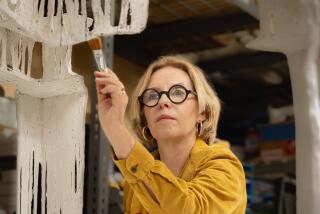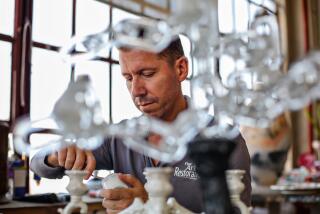A ‘Bridge’ Rebuilt : Restoration of David Lean’s ‘River Kwai’ Raises the Issue of How Good Is Good Enough
- Share via
Film restoration and preservation is a growing faith in Hollywood. Almost everyone is a believer, for commercial if not for altruistic reasons, especially since the successful, high-profile restorations of “Lawrence of Arabia” and “Spartacus.”
And yet some distributors, it appears, aren’t as devout as some restoration specialists would like. As Robert A. Harris, who supervised the “Lawrence” and “Spartacus” restorations, puts it, “Some are willing to settle for good enough. But the standard should be, how good can (a restored film) look?”
Columbia Pictures’ recent restoration of the Oscar-winning 1957 war drama “The Bridge on the River Kwai,” directed by David Lean and starring William Holden and Alec Guinness, is a case in point. Pursued over the last 18 months at a cost of roughly $500,000, Columbia’s effort has sharpened the images, made the colors richer and dramatically enhanced the formerly mono soundtrack, creating a new Dolby stereo version mixed from the original sound elements.
As with “Lawrence,” which Lean also directed, Columbia is looking for a major bump in home video revenues when it offers the wide-screen “Kwai” on videotape and laser disc (in both pan-and-scan and letterbox version) some time in early 1993, following a limited theatrical run. Local fans will get an early peek with the film’s “world premiere” at UCLA’s Melnitz Theater Sunday night, 35 years after its original debut.
The wrinkle is this: Harris, who consulted closely with Lean about restoring “Kwai” before the filmmaker’s death in 1991, had every reason to expect that he would be hired to supervise the “Kwai” restoration. But he was cut out of the loop by Columbia executives, with the reins handed to Jim Painten, Harris’ producing partner on “The Grifters” and restoration colleague on “Lawrence.”
Why? According to sources, Harris was perceived by Jimmy Honore, Columbia’s senior vice president of post-production, as being too demanding in his standards and asking too high a personal fee. Painten agreed to adopt a more modest and collaborative approach. There was also a personality factor. Columbia officials apparently concluded during the “Lawrence” restoration that Harris was inflexible and had, according to one observer, “a very imperious attitude.”
A well-placed Columbia source, declining to be named or quoted, maintains that Painten’s hiring was strictly a business decision and not influenced by negative opinions about Harris.
“Columbia wanted this to be their restoration, not his,” admits Painten, referring to Harris. “I think Bob has caused himself to be left out of things. He believes he’s the only one who knows what’s right.”
Harris, assessing his reputation in the wake of the “Kwai” snub, says half-jokingly, “I’ll never eat lunch in this town again.”
Harris loyalists are more militant. “Painten doesn’t have a fraction of the technical knowledge that Bob has,” said one, “besides the fact that Bob knew David (Lean) intimately and what his thoughts were about improving ‘Kwai.’ Bob is a perfectionist, which is what it’s all about. If you’re not going to be a perfectionist at this game, why bother?”
Painten acknowledges he is “in no way skilled as a restoration technician,” adding, “what matters is hiring the right people for the job.”
How did Painten’s hiring affect the quality of the restoration, and what would have been different if Harris had supervised it? More fundamentally, to what extent does this episode reflect the purist vs. bottom-line choices being made on other restorations projects now under way or being considered?
When Columbia asked Painten for recommendations about restoring “Kwai,” he suggested putting the bulk of the effort into creating a new soundtrack. The film’s original dialogue, music and effects tapes were blended together--along with several newly recorded atmospheric sound effects--into a stereo, multitrack mix. “They really did a great job on the rain effects,” says Harris, who saw a work-in-progress version last February.
Realizing also that the original “Kwai” negative had faded in parts, Painten reconstructed these sections from the original separations and then re-timed (adjusted) the color in each scene to achieve an overall consistency. “What I saw looked beautiful,” says Harris. “They got the jungle greens.”
To the average moviegoer, the differences between the upcoming restored “Kwai” and what Harris might have implemented may seem of little consequence. But they would have probably made a crucial difference to David Lean.
Harris feels that his loyalty to what Lean wanted from the “Kwai” restoration--some of which involved improvements over the version that audiences originally saw in 1957--is what doomed him, and not personality or cost. He claims he submitted a “Kwai” restoration budget to Columbia of roughly $350,000, including his personal fee.
“Dozens of quality compromises are pressed upon you with every restoration,” says Harris. “There were times during the work on ‘Spartacus’ when we had to send film back to the lab five and six times before they got it right. The bottom line was, (Columbia) knew that if something was being done wrong, I wouldn’t go along with it. I know there was frustration on ‘Kwai’ (among the technicians who worked with Painten) over budgetary restrictions. What I would have done would have been quite different.”
The Columbia-Harris split is essentially a replay of an age-old Hollywood clash between status-quo types and lone-wolf visionaries. Both have their rationales and justifications.
According to restoration consultant Mike Arick, who produced the recent “Blade Runner” restoration for Ridley Scott and Warner Bros., Columbia’s attitude is reflective of a general trend among distributors these days to handle restorations in-house, which he feels may ultimately lessen quality. “They’re pushing a corporate approach to problems that require specific, creative solutions,” Arick claims. A restoration veteran who recently worked for a major studio remarks, “It’s like a vice president of Bulova trying to fill the shoes of a Swiss watchmaker.”
Some studio types view restoration efforts with discomfort, claims Michael Schlesinger, Paramount’s manager of theatrical repertory sales. “Any time you restore, upgrade or otherwise improve a film, you’re admitting that you somehow didn’t get it right the first time, or that you were somehow negligent,” he observes. “Some studios don’t like to admit that.”
There are several factors suggesting that in-house restorations may not be as effective as those supervised by independent consultants, according to various sources, a few of whom are admittedly blowing their own horn.
Some studios (including Columbia) refuse to deal with private collectors, who are the best source for locating rare prints or lost elements, because they consider them to be thieves, even though many collectors obtained their prints from studio auctions or throwaways and are sometimes the only ones in possession of materials that do not exist elsewhere.
It has also been suggested that certain studio employees have longstanding kickback relationships with post-production labs that could influence decisions, or that they may lack the independence to select which lab employees are the most precise and best suited for quality restoration work.
“The motives of some of the people calling the shots at the studios are good, but there’s not enough of a commitment,” says Jim Katz, the former Universal and United Artists executive who collaborated with Harris on the “Spartacus” restoration. “It’s just not focused. The decisions about what films should be worked on, and to what extent, are influenced too much by distribution and not enough by history.”
“I’m not damning anything that is being done by others,” Katz continues. “All of that is fine. I’m just trying to get people to raise their standards.” Katz says he’s especially grateful to director Martin Scorsese for lobbying the major studios on behalf of restoration projects. “Without Marty, we would have a lot further to go than we do now.”
The main hurdle, Katz emphasizes, is convincing “the people who own these films that it’s in their interest to restore them. It’s still an uphill battle.”
Harris claims that a head-in-the-sand attitude prevails about the deterioration of hundreds of films in studio vaults. “There are more preservation problems with 35mm classic films than they want to know about,” he says, referring to widespread accounts of studio-maintained film storage facilities with leaky roofs and puddles on the concrete floor.
More to Read
The biggest entertainment stories
Get our big stories about Hollywood, film, television, music, arts, culture and more right in your inbox as soon as they publish.
You may occasionally receive promotional content from the Los Angeles Times.










